1994 PONTIAC BONNEVILLE brake
[x] Cancel search: brakePage 138 of 290
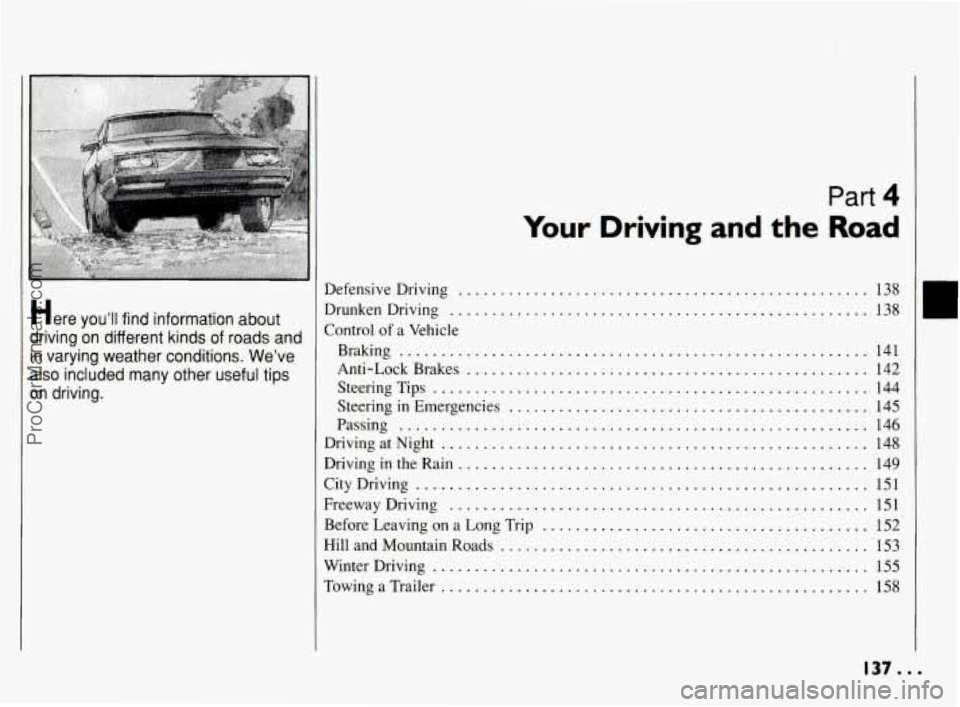
Defensive Driving
Your
................
Part 4
Driving and the Road
.................................
DrunkenDriving ..................................................
'Control of a Vehicle
Bmking .. ......................................................
Anti-LackBrakes ................................................
SteeringTips ....................................................
Steering in Emergencies ...........................................
Passling ........................................................
I)rivin>g in the Rain .................................................
City Driving ......................................................
Freeway Driving ..................................................
DrivingatNight ...................................................
Before Leaving on a Long Trip .......................................
HillandMountainRoads ............................................
WhterDriving ....................................................
Towing a Trailer ...................................................
138
138
141
142
144
145
146
148
149 151
151
152
153
155
158
ProCarManuals.com
Page 139 of 290
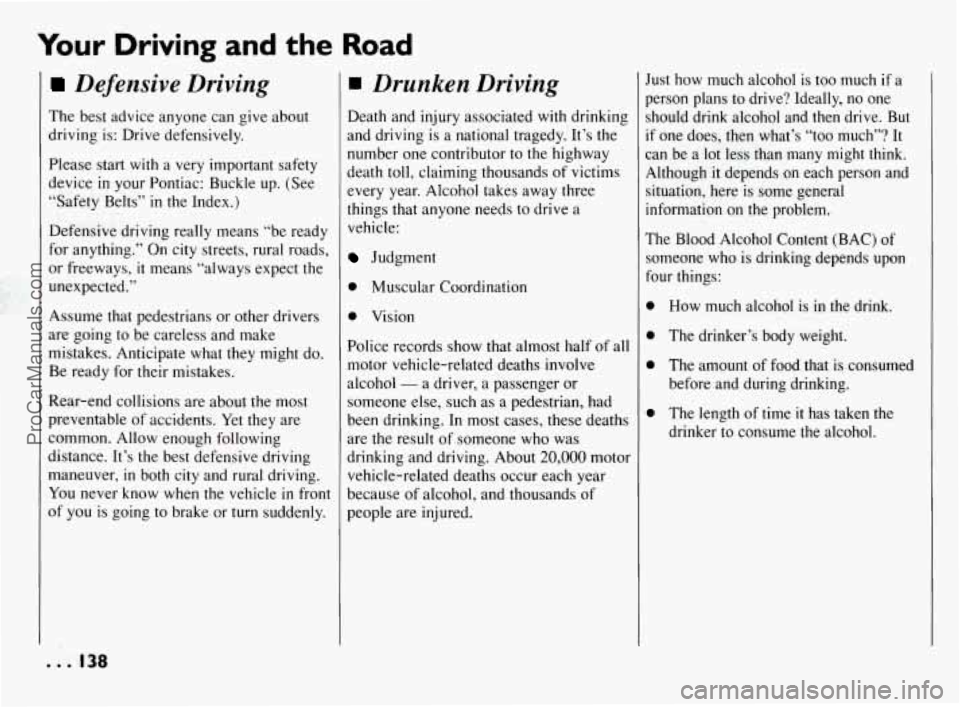
Your Driving and the Road
Defensive Driving
The best advice anyone can give about
driving is: Drive defensively.
Please start with a very important safety
device
in your Pontiac: Buckle up. (See
“Safety Belts’’
in the Index.)
Defensive driving really means “be ready
for anything.” On city streets, rural roads,
or freeways,
it means “always expect the
unexpected.”
Assume that pedestrians or other drivers
are going to be careless and make
mistakes. Anticipate what they might do.
Be ready for their mistakes.
Rear-end collisions are about the most
preventable of accidents. Yet they are
common. Allow enough following
distance.
It’s the best defensive driving
maneuver,
in both city and rural driving.
You never know when the vehicle in front
of you is going to brake or turn suddenly.
Drunken Driving
Death and injury associated with drinking
and driving is a national tragedy.
It’s the
number one contributor to the highway
death toll, claiming thousands of victims
every year. Alcohol takes away three
things that anyone needs to drive a
vehicle:
Judgment
0 Muscular Coordination
0 Vision
Police records show that almost half of all
motor vehicle-related deaths involve
alcohol
- a driver, a passenger or
someone else, such as a pedestrian, had
been drinking. In most cases, these deaths
are the result of someone who was
drinking and driving. About
20,000 motor
vehicle-related deaths occur each year
because of alcohol, and thousands
of
people are injured. Just how much
alcohol is
too much if a
person plans to drive? Ideally, no one
should drink alcohol and then drive.
But
if one does, then what’s “too much”? It
can be a lot less than many might
think.
Although it depends on each person and
situation, here is some general
information on the problem.
The Blood Alcohol Content (BAC)
of
someone who is drinking depends upon
four things:
0
How much alcohol is in the drink.
The drinker’s body weight.
The amount
of food that is consumed
before and during drinking.
The length
of time it has taken the
drinker to consume the alcohol.
... 138
ProCarManuals.com
Page 142 of 290
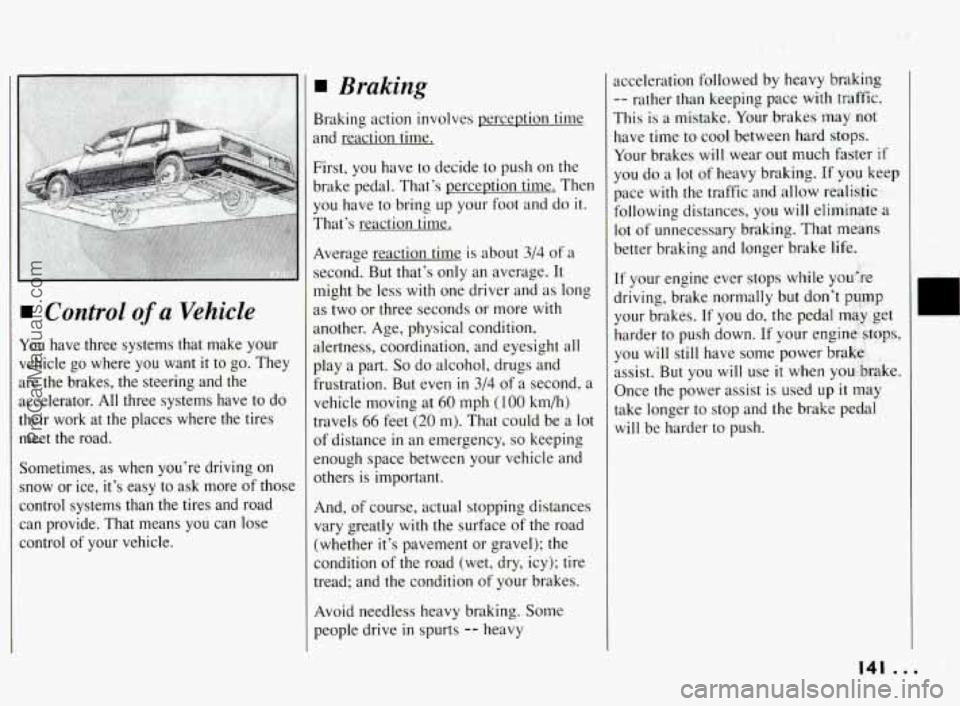
You have three systems that make your
vehicle
go where you want it to go. They
are the brakes, the steering and the
accelerator.
All three systems have to do
their
work at the places where the tires
meet the road.
Sometimes, as when you’re driving on
snow or ice, it’s easy to ask more of those
control systems than the tires and road
can provide. That means you can lose
control
of your vehicle. And,
of course, actual stopping distances
vary greatly with
the surface of the road
(whether it’s pavement or gravel); the
condition
of the road (wet, .dry, icy); tire
tread; and the condition
of your brakes.
Avoid needless heavy braking. Some
people drive
in spurts -- heavy
141 ...
ProCarManuals.com
Page 143 of 290
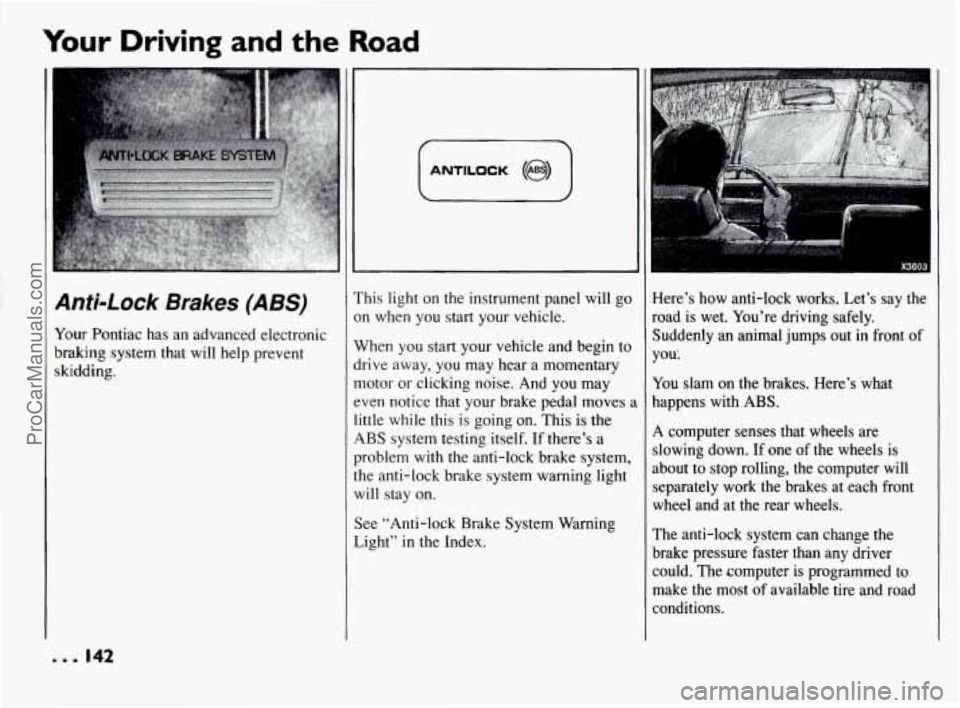
Your Driving and the Road
I
Anti-Lock Brakes (ABS)
Your Pontiac has an advanced electronic
braking system that will help prevent
skidding.
1 ANTILOCK @) 1
This light on the instrument panel will go
on when
you start your vehicle.
When you start your vehicle and begin to
drive away, you may hear a momentary
motor or clicking noise. And you may
even notice that your brake pedal moves
2
little while this is going on. This is the
ABS system testing itself. If there’s a
problem with the anti-lock brake system,
the anti-lock brake system warning light will stay on.
See “Anti-lock Brake System Warning
Light” in the Index. Here’s how anti-lock works. Let’s say the
road
is wet. You’re driving safely.
Suddenly an animal jumps out in front of
you:
You slam on the brakes. Here’s what
happens with
ABS.
A computer senses that wheels are
slowing down.
If one of the wheels is
about to stop rolling, the computer will
separately work the brakes at each front
wheel and at the rear wheels.
The anti-lock system can change the brake pressure faster than any driver
could. The computer is programmed
to
make the most of available tire and road
conditions.
... 142
ProCarManuals.com
Page 144 of 290
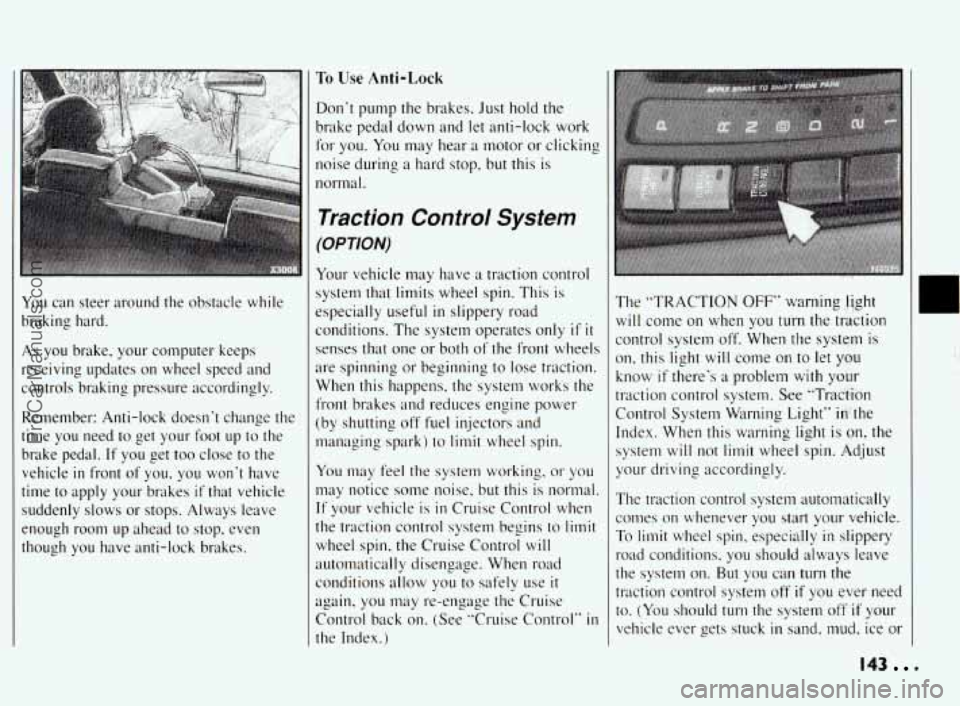
I
You can steer around the obstacle while
braking hard.
As you brake, your computer keeps
receiving updates
on wheel speed and
controls braking pressure accordingly.
Remember: Anti-lock doesn‘t change the
time you need to get your foot up to the
brake pedal.
If you get too close to the
vehicle
in front of you, you won’t have
time to apply your brakes
if that vehicle
suddenly slows
or stops. Always leave
enough room up ahead
to stop, even
though you have anti-lock brakes.
To Use Anti-Lock
Don’t pump the brakes. Just hold the
brake pedal down and let anti-lock work
for you.
You may hear a motor or clicking
noise during a hard stop, but
this is
normal.
Traction Control System
(OPTION)
Your vehicle may have a traction control
system that limits wheel spin. This is
especially useful
in slippery road
conditions. The system operates only
if it
senses that one or both of the front wheels
are spinning or beginning to lose traction.
When this happens, the system works the
front brakes and reduces engine power
(by shutting off fuel injectors and
managing spark) to
limit wheel spin.
You may feel the system working, or you
may notice some noise, but this is normal.
If your vehicle is in Cruise Control when
the traction control system begins
to limit
wheel spin, the Cruise Control will
auto~natically disengage. When road
conditions allow you to safely use
it
again, you may re-engage the Cruise
Control back on. (See “Cruise Control”
in
the Index.) The “TRACTION
OFF” warning
light
will come on when you turn the traction
control system off.
When the system is
on, this light will come
on to let you
know if there’s a problem with your
traction control system. See “Traction
Control System Warning Light” in’the
Index. When this warning light is on, the
system
will not limit wheel spin. Adjust
your driving accordingly.
The traction control system automatically
comes on whenever you start
your vehicle.
To limit wheel spin, especially
in slippery
road conditions, you should always leave
the system
on. But you can turn the
traction control system
off if you ever need
to. (You should
turn the system off if your
vehicle ever gets stuck
in sand. mud, ice or
143
ProCarManuals.com
Page 145 of 290

Your Driving and the Road
Traction Control System
(OPTION) (CONI)
snow. See “Rocking Your Vehicle” in the
Index.)
To turn the system off, press the
“TRACTION CONTROL” button.
The “TRACTION
OFF” warning light
will come on and stay on. If the system is
limiting wheel spin when
you press the
button, the system won’t turn off right
away. It will wait until there’s no longer a
current need to limit wheel spin.
You can turn the system back on at any
time by pressing the button again. The
“TRACTION
OFF” warning light
should go off.
Braking in Emergencies
Use your anti-lock braking system when
you need to. With anti-lock, you can steer
and brake at the same time. In many
emergencies, steering can help
you more
than even the very best braking.
Steering
Power Steering
If you lose power steering assist because
the engine stops or the system is not
functioning,
you can steer but it will take
much more effort.
Variable Effort Steering
If your vehicle is equipped with this
option,
you have a variable effort steering
system that eases steering effort at speeds
less than
20 mph (32 km/h). This is
particularly useful when parking your
vehicle.
Steering Tips
Driving on Curves
It’s important to take curves at a
reasonable speed.
A lot of the “driver lost control” accidents
mentioned on the news happen on curves.
Here’s why: Experienced driver or beginner, each
of
us is
subject to the same laws of physics
when driving on curves. The traction
of
the tires against the road surface makes it
possible for the vehicle to change its path when
you turn the front wheels. If there’s
no traction, inertia will keep the vehicle
going in the same direction. If you’ve
ever tried to steer a vehicle on wet
ice,
you’ll understand this.
The traction you can get in a curve
depends on the condition of your tires and
the road surface;
the angle at which the
curve is banked, and your speed. While
you’re in a curve, speed is the one factor
you can control.
Suppose you’re steering through a sharp
curve. Then
you suddenly accelerate.
Both control systems
-- steering and
acceleration
-- have to do their work
where the tires meet the road. Unless
you
have traction control and the system is on,
adding the sudden acceleration can
demand too much
of those places. You
can lose control.
... 144
ProCarManuals.com
Page 146 of 290
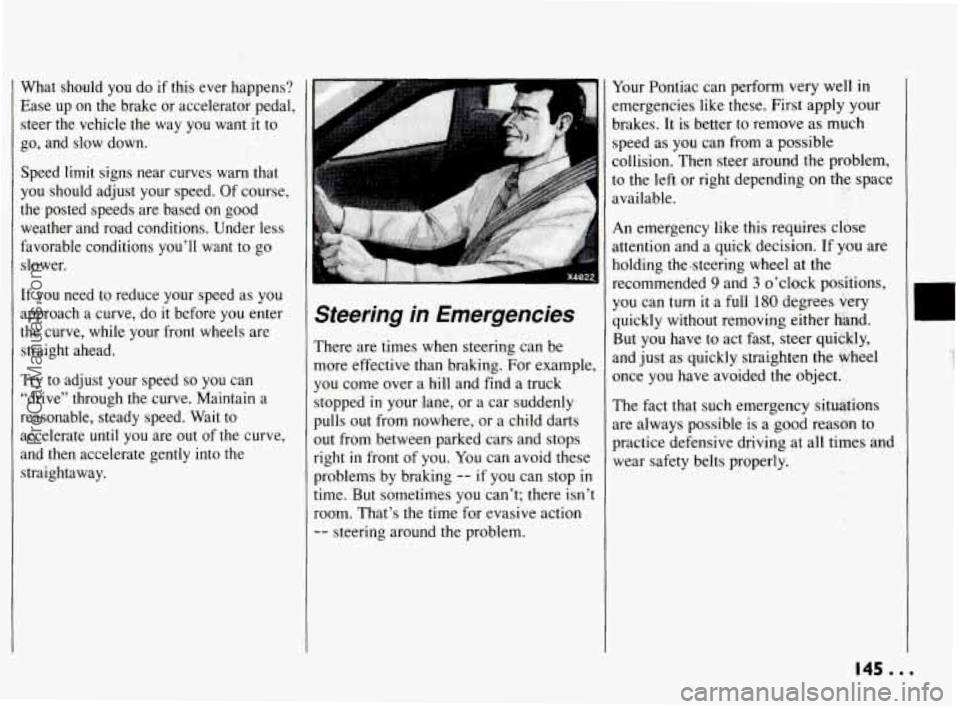
What should you do if this ever happens?
Ease up on the brake or accelerator pedal,
steer the vehicle the way you want it to
go, and slow down.
Speed limit signs near curves warn that
you should adjust your speed. Of course,
the posted speeds are based on good
weather and road conditions. Under less
favorable conditions you’ll want to
go
slower.
If you need to reduce your speed as you
approach a curve, do
it before you enter
the curve, while your front wheels are
straight ahead.
Try to adjust your speed
so you can
“drive” through the curve. Maintain a
reasonable, steady speed. Wait to
accelerate until you are out of the curve,
and then accelerate gently into the
straightaway.
Steering in Emergencies
There are times when steering can be
more effective than braking. For example,
you come over a hill and find a truck
stopped
in your lane, or a car suddenly
pulls out from nowhere, or a child darts
out from between parked cars and stops
right
in front of you. You can avoid these
problems by braking
-- if you can stop in
time. But sometimes you can’t; there isn’t
room. That’s the time for evasive action
-- steering around the problem. Your
Pontiac can perform very well in
emergencies like these.
First apply your
brakes. It is better to remove as much
speed as you can
from a possible
collision. Then steer around the problem,
to the left or right depending on the space
available.
An emergency like this requires close
attention and a quick decision. If you are
holding the-steering wheel at the
recommended
9 and 3 o’clock positions,
you can turn
it a full 180 degrees very
quickly without removing either hand.
But you have to act fast, steer quickly,
and just as quickly straighten the wheel
once you have avoided the object.
The fact that such emergency situations
are always possible is a good reason to
practice defensive driving at all times and
wear safety belts properly.
145...
ProCarManuals.com
Page 148 of 290
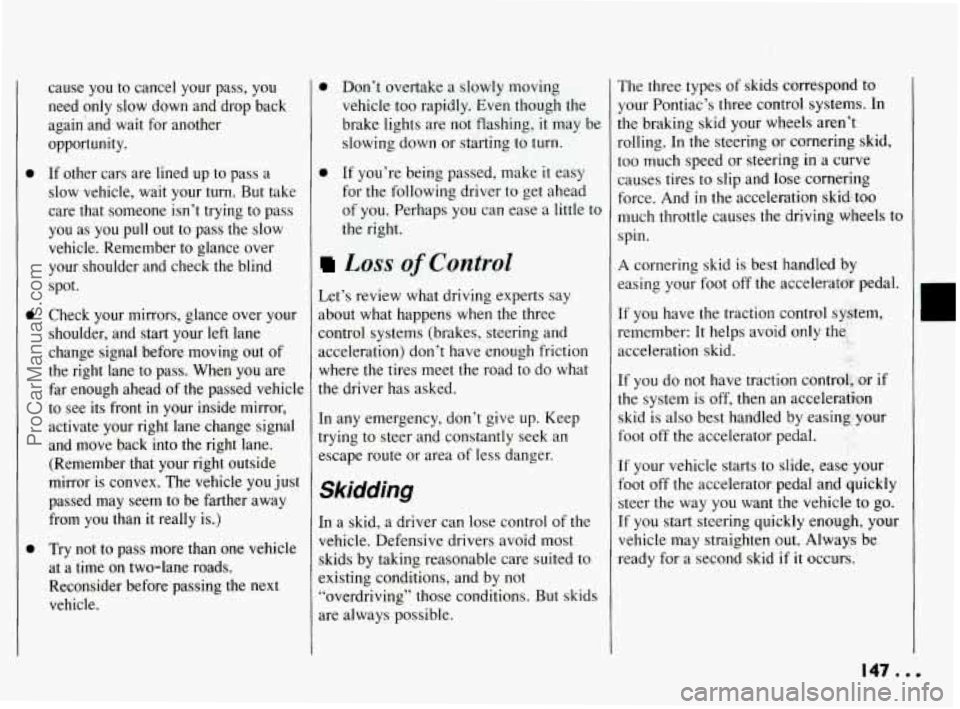
0
0
0
cause you to cancel your pass, you
need only slow down and drop back
again’and wait for another
opportunity.
If other cars are lined up to pass a
slow vehicle, wait your turn. But take
care that someone isn’t trying to pass
you as you pull out to pass the slow
vehicle. Remember to glance over
your shoulder and check the blind
spot.
Check your mirrors, glance over your
shoulder, and start your left lane
change signal before moving out of
the right lane to pass. When you are
far enough ahead of the passed vehicle
to see its front
in your inside mirror,
activate your right lane change signal
and move back into the right lane.
(Remember that your right outside
mirror is convex. The vehicle you just
passed may seem to be farther away
from you than it really is.)
Try not to pass more than one vehicle
at a time on two-lane roads.
Reconsider before passing the next
vehicle.
0 Don’t overtake a slowly moving
vehicle too rapidly. Even though the
brake lights are not flashing, it may be
slowing down or starting to turn.
0 If you’re being passed, make it easy
for the following driver
to get ahead
of you. Perhaps you can ease a little to
the right.
Loss of Control
Let’s review what driving experts say
about what happens when the three
zontrol systems (brakes, steering and
acceleration) don’t have enough friction
where the tires meet the road to do what
the driver has asked.
In any emergency, don’t give up. Keep
trying to steer and constantly seek an
escape route or area of less danger.
Skidding
In a skid, a driver can lose control of the
vehicle. Defensive drivers avoid most
skids by taking reasonable care suited to
existing conditions, and by not
“overdriving” those conditions. But skids
are always possible. The
three types of skids correspond
to
your Pontiac’s three control systems. In
the braking skid your wheels aren’t
rolling. In the steering
or cornering skid,
too much speed or steering in a curve
causes tires to slip and lose cornering
force. And
in the acceleration skic€-.too
much throttle causes the driving wheels to
spin.
A cornering skid is best handled by
easing your foot off the accelerato? pedal.
If you have the traction control system,
remember: It helps avoid only the,
acceleration skid.
If you do not have traction control$ or if
the system is off, then an acceleration
skid is
also best handled by easing your
foot off the accelerator pedal.
If your vehicle starts to slide, ease your
foot off the accelerator pedal and quickly
steer the way you want the vehicle to
go.
If you start steering quickly enough, your
vehicle may straighten out. Always
be
ready for a second skid if it occurs.
147...
ProCarManuals.com